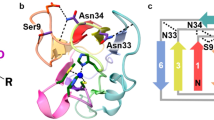Abstract
The single Fe(II) in reduced rubredoxin from Clostridium pasteurianum was found to be quantitatively displaced by either Cd2+ or Zn2+ when a modest molar excess of the substituting metal salt was anaerobically incubated with the reduced rubredoxin under mild conditions, namely, room temperature, pH 5.4–8.4, and no protein denaturants. Under the same conditions, cadmium-for-zinc substitution was also achieved upon aerobic incubation of the zinc-substituted rubredoxin with a modest molar excess of Cd2+. Displacements of Fe(II) from the reduced rubredoxin were not observed upon anaerobic incubation with Ni2+, Co2+, or VO2+ salts, and no reaction with any of the divalent metal ions was observed for the oxidized [Fe(III)] rubredoxin. Fe(II) could not be re-inserted into the Zn- or Cd-substituted rubredoxins without resorting to protein denaturation. 1H and 113Cd NMR experiments showed that the cadmium-substituted rubredoxin prepared by the non-denaturing substitution method retained the pseudotetrahedral M(SCys)4 coordination geometry and secondary structural elements characteristic of the native rubredoxin, and that "unzipping" of the β-sheet did not occur during metal substitution. Rates of Fe(II) displacement by M2+ (M=Cd or Zn) increased with increasing M2+/rubredoxin ratio, decreasing pH, and lower ionic strength. The substitution rates were faster for M=Cd than for M=Zn. Rates of Cd2+ substitution into a V8A-mutated rubredoxin were significantly faster than for the wild-type protein. The side-chain of V8 is on the protein surface and close to the metal-ligating Cys42Sγ at the M(SCys)4 site. Therefore, the rate-limiting step in the substitution process is suggested to involve direct attack of the [M(SCys)4]2– site by the incoming M2+, without global unfolding of the protein. Implications of these results for metal ion incorporation into rubredoxins in vivo are discussed.
Similar content being viewed by others
Author information
Authors and Affiliations
Consortia
Additional information
Received: 29 May 1998 / Accepted: 11 August 1998
Rights and permissions
About this article
Cite this article
Bonomi, F., Iametti, S., Kurtz Jr., D. et al. Direct metal ion substitution at the [M(SCys)4]2– site of rubredoxin. JBIC 3, 595–605 (1998). https://doi.org/10.1007/s007750050272
Issue Date:
DOI: https://doi.org/10.1007/s007750050272




